Valdora
Author: Michael Schacht
Publisher: AbacusSpiele
Year: 2009
review by

| x |
|
|
|
|
|
|
|
|
|
|
|
|
|
|
|
|
|
|
|
|
|
|
|
|
|
|
|
|
|
|
|
|
|
|
|
|
|
|
|
|
|
|
|
|
|
 |
Looking for fortune players travel through Valdora, where the gems are piled up on the side of the road, literally for the taking. The wealthy families that inhabit the surroundings also would like their share in the riches, but they prefer not to leave their comfortable homes to get them. Outside it might be dangerous, and maybe they'll get tired as well. Instead, they decide to publish their wishes in big catalogues in the city. That is where players come in, equipped with backpacks and all sorts of equipment, to collect gems and deliver them to their houses. In exchange for victory points, of course. When business is going well, players can afford to hire craftsmen and workshops, which further increases their income.
|
| x |
|
|
|
|
|
|
|
|
|
|
|
|
|
|
|
|
|
|
|
|
|
|
|
|
|
|
|
|
|
|
|
|
|
|
|
|
|
|
|
|
|
|
|
|
|
|
On the roads in Valdora, piles of six gems are placed. In two cities backpacks and other equipment can be purchased from a catalogue, and in two other cities the catalogues with assignments can be found. The catalogues are designed as piles of cards on a wooden frame that looks like a book. Players can even leaf through the catalogues. In addition, there are mines where silver coins can be found, and harbours where even more gems can be collected.
|
|
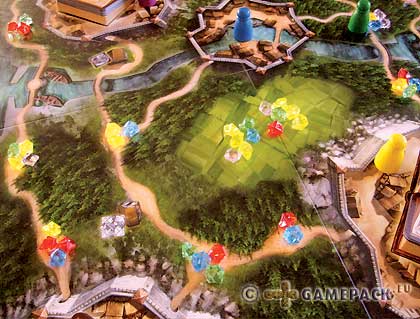 |
| x |
|
|
|
|
|
|
|
|
|
|
|
|
|
|
|
|
|
|
|
|
|
|
|
|
|
|
|
|
|
|
|
|
|
|
|
|
|
|
|
|
|
|
|
|
|
 |
|
In a turn a player may move as far as he wants, until he reaches a city. He can subsequently perform one action on the location where he decides to end his movement. If the location is already occupied by another player, he has to pay this player one coin.
|
| x |
|
|
|
|
|
|
|
|
|
|
|
|
|
|
|
|
|
|
|
|
|
|
|
|
|
|
|
|
|
|
|
|
|
|
|
|
|
|
|
|
|
|
|
|
|
|
If a player ends his movement next to a pile of gems, he may collect as many gems as he can carry. Every backpack offers room for one gem in a specific colour; everybody starts with a backpack with room for one golden gem. A horse and a carriage are also for sale; they can contain one gem of a colour of a players choice, but it costs 2 or 3 coins to load the gem. In a harbour a player may collect as many gems as there are ships in the harbour, 1 or 2, from the central meadow that gets filled by the gems from completed assignments and acts as the general stock.
In a silver mine, a player may restock his money supply to six coins.
|
|
 |
| x |
|
|
|
|
|
|
|
|
|
|
|
|
|
|
|
|
|
|
|
|
|
|
|
|
|
|
|
|
|
|
|
|
|
|
|
|
|
|
|
|
|
|
|
|
|
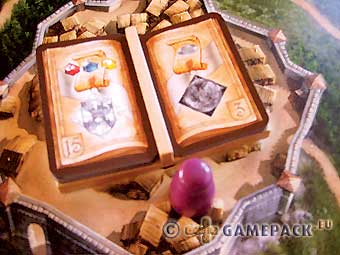 |
|
In a city, he may leaf through the catalogue and purchase cards from the catalogue. All backpacks cost one golden gem, all assignments cost one silver coin. A player may turn one page at no cost, if he wants to turn additional pages, it costs one coin per page. A player may possess a maximum of three assignments, and only one backpack of each colour. Another option in the city is to obtain food. This comes down to turning his traveller card to the side that depicts food. If a player possesses food, he doesn’t have to stop his movement as soon as he enters a city, but may continue until the next city. Afterwards the card is turned back to its foodless side.
|
| x |
|
|
|
|
|
|
|
|
|
|
|
|
|
|
|
|
|
|
|
|
|
|
|
|
|
|
|
|
|
|
|
|
|
|
|
|
|
|
|
|
|
|
|
|
|
|
The assignments have a large coloured shield of the house where the gems have to be delivered, and the colour of the desired gems. If a player possesses an assignment and the required gems, he can deliver the whole bunch to this house. He places the gems back in the general stock, and places the assignment card under his traveller card.
|
|
 |
| x |
|
|
|
|
|
|
|
|
|
|
|
|
|
|
|
|
|
|
|
|
|
|
|
|
|
|
|
|
|
|
|
|
|
|
|
|
|
|
|
|
|
|
|
|
|
 |
|
|
|
| x |
|
|
|
|
|
|
|
|
|
|
|
|
|
|
|
|
|
|
|
|
|
|
|
|
|
|
|
|
|
|
|
|
|
|
|
|
|
|
|
|
|
|
|
|
|
In addition, he takes a craftsman in the colour of the house where he just delivered. If a player is the first to collect two to five - depending on the colour - craftsmen of the same colour, he receives the workshop in that colour. They score 0 or 5 points at the end of the game, but more importantly, they allow a player to take a token of 10 points each time he makes a delivery at the house of that same colour.
The game ends as soon as there is only one colour stack of craftsmen left. The players receive points for their fulfilled assignments, their workshops, their 10 point tokens and the number of different craftsmen they possess. |
| x |
|
|
|
|
|
|
|
|
|
|
|
|
|
|
|
|
|
|
|
|
|
|
|
|
|
|
|
|
|
|
|
|
|
|
|
|
|
|
|
|
|
|
|
|
|
| x |
|
|
|
|
|
|
|
|
|
|
|
|
|
|
|
|
|
|
|
|
|
|
|
|
|
|
|
|
|
|
|
|
|
|
|
|
|
|
|
|
|
|
|
|
|
| x |
|
|
|
|
|
|
|
|
|
|
|
|
|
|
|
|
|
|
|
|
|
|
|
|
|
|
|
|
|
|
|
|
|
|
|
|
|
|
|
|
|
|
|
|
|
 |
|
|
|
|
|
|
|
|
|
|
|
|
|
|
|
|
|
|
|
|
|
|
|
|
|
|
|
|
|
|
|
|
|
|
|
|
|
|
|
|
|
| Valdora is a friendly game. Gems, money, it is all rather easy to come by. The rules are simple, and the game can be used as a family game. But, for those who are looking for it, there is also strategy! |
| x |
|
|
|
|
|
|
|
|
|
|
|
|
|
|
|
|
|
|
|
|
|
|
|
|
|
|
|
|
|
|
|
|
|
|
|
|
|
|
|
|
|
|
|
|
|
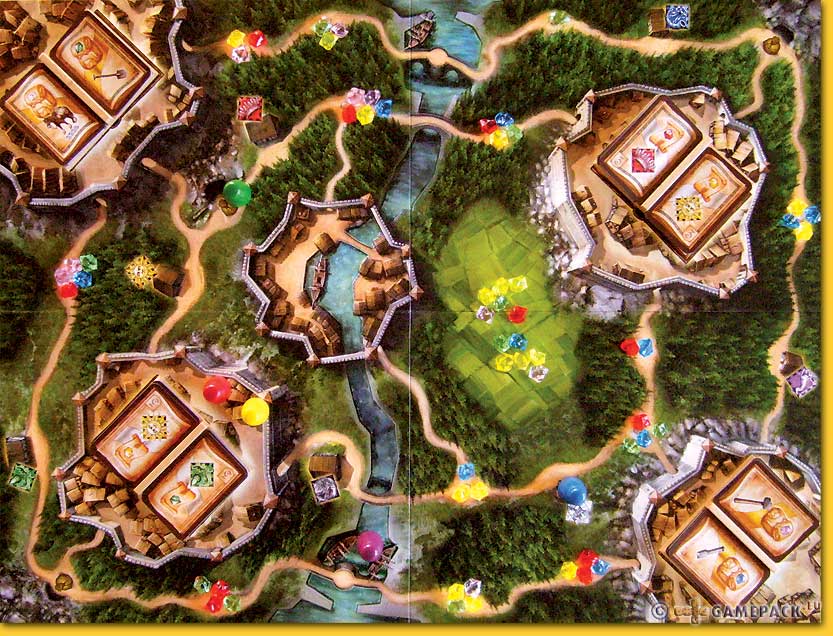 |
| x |
|
|
|
|
|
|
|
|
|
|
|
|
|
|
|
|
|
|
|
|
|
|
|
|
|
|
|
|
|
|
|
|
|
|
|
|
|
|
|
|
|
|
|
|
|
| It is often rather obvious what another player is up to, and it is not too hard to frustrate him in the process. If someone does not have a backpack for red gems yet, and there is one displayed on the top page of the catalogue, a player can snatch it away before the other gets the chance. Or he can turn a couple of pages, so that another player has to pay money to turn them back to get to the desired item. Or, even simpler, he can just stand in the same city, so that the other player at least has to pay a coin; and maybe he is temporarily out of silver! |
| x |
|
|
|
|
|
|
|
|
|
|
|
|
|
|
|
|
|
|
|
|
|
|
|
|
|
|
|
|
|
|
|
|
|
|
|
|
|
|
|
|
|
|
|
|
|
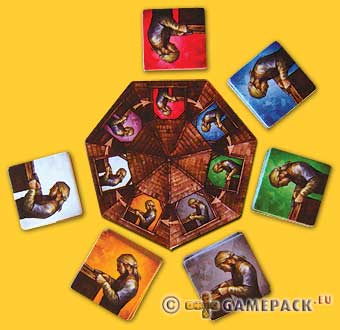 |
|
Because craftsmen are scarce, and tscore quite a lot of points at the end of the game, it is important to get them as long as they are still available. Also here a player can frustrate an opponent by taking the last craftsman of a certain colour.
|
| x |
|
|
|
|
|
|
|
|
|
|
|
|
|
|
|
|
|
|
|
|
|
|
|
|
|
|
|
|
|
|
|
|
|
|
|
|
|
|
|
|
|
|
|
|
|
But of course players can't spend the whole game annoying others, so they will have to move on theirselves! There are several options to score huge amounts of points. Players are allowed to fulfil multiple assignments in one turn, but only if they possess all the required gems. As for instance the blue house asks for blue gems, a player has to carry multiple gems of this colour. Since he may have only one backpack of each colour, he needs the horse and carriage to do this, but they are rather expensive to use.
|
|
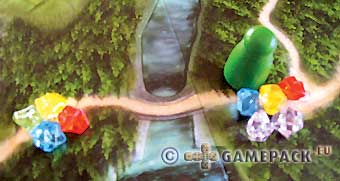 |
| x |
|
|
|
|
|
|
|
|
|
|
|
|
|
|
|
|
|
|
|
|
|
|
|
|
|
|
|
|
|
|
|
|
|
|
|
|
|
|
|
|
|
|
|
|
|
 |
| 'Only put your silver outside on the morning of pickup.' |
|
|
On the other hand, the grey house only demands coins, and since players are allowed to carry six coins, a player can easily fulfil three grey assignments in one turn by paying three coins. The white house demands three different gems, but they pay 15 victory points for this! All other assignments are only 3 points. There are only six white assignments, so a player either has to be lucky to get some, or has to leaf through the catalogues a lot to retrieve them! |
| x |
|
|
|
|
|
|
|
|
|
|
|
|
|
|
|
|
|
|
|
|
|
|
|
|
|
|
|
|
|
|
|
|
|
|
|
|
|
|
|
|
|
|
|
|
|
|
May we complain about the graphics for a second? The assignment and equipment cards are a disaster!! Okay, one depicts a piece of parchment, the other a backpack, but the colour and atmosphere is so identical that they are really hard to distinguish, especially at the other side of the table where the opponents are sitting. Additionally, there are two stacks of each type of cards, one for each city, that should be distinguishable by a dark, or a light frame. Well, even though it is mentioned in the rulebook, most people cannot even see the difference even if they know what to look for! This often results in unnecessary confusion and irritation. Cute, this old fashioned book-look, but functionality should always be the priority!
|
|
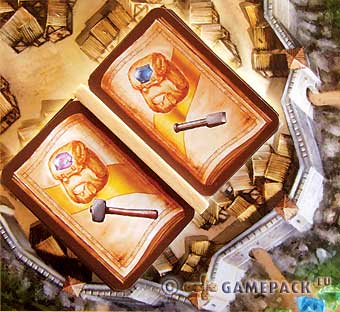 |
| x |
|
|
|
|
|
|
|
|
|
|
|
|
|
|
|
|
|
|
|
|
|
|
|
|
|
|
|
|
|
|
|
|
|
|
|
|
|
|
|
|
|
|
|
|
|
|
Valdora has a nice balance between 'for yourself' and 'against the other'. You always have so many options that you'll never get completely stuck and frustrated, which makes it a nice and friendly game with enough challenge, that can be played in little over an hour.
© 2009 Barbara van Vugt
Valdora, Michael Schacht, Abacus Spiele, 2009 - 3 to 5 players, 10 years and up, 60 minutes
|
  |
|
|
|
|
|
|
|
|
|
|
|
|
|
|
|
|
|
|
|
|
|
|
|
|
|
|
|
|
|
|
|
|
|
|
|
|
|
|
|
|
|
  |
|
|
|
|
|
|
|
|
|
|
|
|
|
|
|
|
|
|
|
|
|
|
|
|
|
|
|
|
|
|
|
|
|
|
|
|
|
|
|
|
|
  |
Planning and efficiency game in a nice outfit |
  |
|
|
|
|
|
|
|
|
|
|
|
|
|
|
|
|
|
|
|
|
|
|
|
|
|
|
|
|
|
|
|
|
|
|
|
|
|
|
|
|
|
  |
|
|
|
|
|
|
|
|
|
|
|
|
|
|
|
|
|
|
|
|
|
|
|
|
|
|
|
|
|
|
|
|
|
|
|
|
|
|
|
|
|
  |
|
|
|
|
|
|
|
|
|
|
|
|
|
|
|
|
|
|
|
|
|
|
|
|
|
|
|
|
|
|
|
|
|
|
|
|
|
|
|
|
|
| x |
|
|
|
|
|
|
|
|
|
|
|
|
|
|
|
|
|
|
|
|
|
|
|
|
|
|
|
|
|
|
|
|
|
|
|
|
|
|
|
|
|
|
|
|
|
| x |
|
|
|
|
|
|
|
|
|
|
|
|
|
|
|
|
|
|
|
|
|
|
|
|
|
|
|
|
|
|
|
|
|
|
|
|
|
|
|
|
|
|
|
|
|
 |
|
|
|
|
|
|
|
|
|
|
|
|
|
|
|
|
|
|
|
|
|
|
|
|
|
|
|
|
|
|
|
|
|
|
|
|
|
|
|
|
|
 |
|
|
|
|
|
|
|
|
|
|
|
|
|
|
|
|
|
|
|
|
|
|
|
|
|
|
|
|
|
|
|
|
|
|
|
|
|
|
|
|
|
| x |
|
|
|
|
|
|
|
|
|
|
|
|
|
|
|
|
|
|
|
|
|
|
|
|
|
|
|
|
|
|
|
|
|
|
|
|
|
|
|
|
|
|
|
|
|
 |
|
|
|
|
|
|
|
|
|
|
|
|
|
|
|
|
|
|
|
|
|
|
|
|
|
|
|
|
|
|
|
|
|
 |
|
|
|
|
|
|
|
|
|
|
|
|
|
|
|
|
|
|
|
|
|
|
|
|
|
|
|
|
|
|
|
|
|
|
|